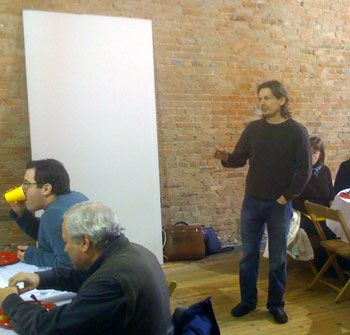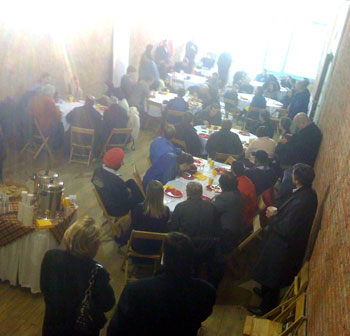Building Coworking Space Brick By Brick

Michael Kessler queries potential users of coworking space at 118 S. Main about what they'd commit to and at what price. (Special thanks to Bill Merrill, who lent The Chronicle his camera.)
At noon on Tuesday, around 50 people gathered in the space at 118 S. Main St. to evaluate its potential as a place for coworking by independent operators. Coworking includes income-earning activity that ranges from people working solo in physical proximity with other independent workers, to collaboration with some of them on a single project – without belonging to a common business concern.
But it wasn’t just the physical space that people were keen to see (over a free catered lunch). They also wanted to know what Michael Kessler had in mind for the actual space-use agreements. Kessler has an arrangement with Ed Shaffran, who owns the Goodyear Building which houses the potential coworking space.
So what people wanted to know from Kessler on Tuesday was: What do you get, and how much does it cost? And what Kessler wanted to know from attendees was: Would you actually use this space, and how much would you pay?
After brief introductory remarks by Kessler, the conversation threatened briefly to stall until Bill Tozier piped up. Tozier, who is affiliated with Not An Employee, which is a standard-bearer for coworking in Ann Arbor, exhorted Kessler: “Describe the space!” What everyone could see were the bare brick walls that are a common feature of Shaffran’s properties. Common enough, that Shaffran knows you are kidding if you suggest to him, as The Chronicle did, that what the bricks need is a good coat of paint. Patrons of Arcadian Too Antiques, which was the most recent tenant there, will not remember exposed brick walls in the store. Part of the work Kessler has had done in the last few weeks is remove the plaster from the bricks.

The view from the mezzanine level. The bright light is from the Main Street side. (Special thanks to Bill Merrill, who lent The Chronicle his camera.)
What Tozier meant, of course, was that Kessler needed to describe what the roughly 3,000 square foot space would look like when configured for coworking. Kessler ticked off various features: a meeting area, a bathroom, a 12-person conference room, a training area, lockers for security, and a place to pick up mail.
The ability to receive mail at a Main Street Ann Arbor address was a real plus for Jessica Rauch, president of The Generation Project. After the presentation, she told The Chronicle that The Generation Project would be moving to Washington D.C. in a year and a half, but that in the meantime, she was keen to have space to work from that was not her apartment.
A concern expressed in small talk before Kessler’s presentation, as well as during the ensuing conversation, was: How does noise get regulated in the coworking space? The noise issue was illustrated perfectly during a back-and-forth between Kessler and Dan Cooney, who were both speaking from the middle of the room. Off to the front of the building, Cooney’s comments were rendered almost indiscernible on that side of the room by conversational noise in the same corner. Conversational volume management in that case came in the form of a finger snap.
Other logistical challenges of managing a shared space include access. One attendee wanted to know if she’d be able to get into the space during later, evening hours, because she works for a west coast company. Answer: The intention is to provide 24/7 availability though a key card system most likely to be installed on the side entrance. Users of the space would swipe in and out.
Swiping would not be necessary to open the door to get out, but having a record of exactly when the space was being used would be helpful moving forward in arranging availability. The idea of being able to check the current physical space usage without physically going there met with a lot of enthusiasm in the room: If you can see online that there are already a full complement of people using the space, it saves showing up only to be disappointed that there’s no room for you to cowork at that particular time.
Generally there was a lot of positive sentiment expressed in the room on Tuesday, even if there was some caution that could be found in internet backchannels. People said they really wanted to see the space succeed. Interest in the existence of a coworking space in Ann Arbor (or at least interest in measuring interest) goes at least as far back as May 2008. Based on a Chronicle conversation with Jennifer Burn after the presentation, that interest could go back even further. Before moving to a South State Street location in late 2005, Burn said, ICON Creative Technologies Group used to lease out work space to independent operators. And according to Jacqueline Yang, of Zattoo Inc., sub-leasing work space to independents is a practice they have adopted as well after recent downsizing. Yang was attending the Tuesday lunch partly with an eye towards possible use of the coworking space by a local initiative for Tech Cocktail.

Drawing of the street entrance to the coworking space. (Special thanks to Bill Merrill, who lent The Chronicle his camera.)
What the coworking space is imagined to be was clarified a bit on Tuesday when David Bloom, executive in residence at Ann Arbor SPARK, contrasted it with the space that SPARK offers through its business incubators. The incubators, said Bloom at Tuesday’s lunch, are “not about community – it’s about business acceleration.” The tenants of its incubators, continued Bloom, have the ambition to create lots of jobs and revenues.
So the coworking space on South Main is not meant as an incubator in that sense. But it’s also meant to be more than coffee houses – with their attendant overhead music, sometimes dodgy Wifi connections, and non-guaranteed access to electrical power for a laptop computer. Still, the South Main space will likely provide a coffee kiosk, staffed probably by Mighty Good Coffee, which had its brew on hand Tuesday for lunch. In addition to providing “eyes-on-site,” the kiosk at the entrance off the street would provide an interface zone between the public street and the private coworking space further back.
The public conversation on Tuesday yielded a show of about 30 hands of people who’d be interested in access to the coworking space at $100 per month. To get to the $10,000 a month that Kessler says he needs to make it work, that means the 30 hands will need to actually commit and get a couple of friends to commit as well.
Reached by phone the day after the lunch, Kessler said that followup communication with lunch attendees was positive enough that he’s got workers executing on the designs that people saw at the lunch, which had been drawn up by architect Clifford Cushard of Cushard Design Associates. Target date for the construction of the space is March 2009. The user agreements still need to be hammered out by legal counsel.
But now after hearing feedback from the potential users – about the physical space and the desired kinds of uses – Kessler said he’s developing a concrete and specific plan. As he put it at Tuesday’s lunch, he is “the decider,” which drew a laugh. But by phone, Kessler allowed that how the space actually gets used, and the day-to-day patterns that evolve, will be determined by those who are actually using the space.
[Editor's note: Please direct inquiries about the coworking space to Michael Kessler at coworkinga2 [at] gmail [daht] com]





Fascinating concept. I look forward to seeing the idea of this space and coworking evolve.
Unfortunately this article was difficult to read because of typeface overlap/jumble and lapses which were not resolved by changing the font size.
Info on the Zattoo coworking suite:
http://a2geeks.org/display/geek/2009/01/14/Coworking+at+Zattoo
We’re mostly interested in other high-tech startup folks for the suite, either with their own small companies, or working remote (e.g. our friends at NVIDIA, Mozilla, Yelp, etc.).
Here’s a video tour of the space:
http://vimeo.com/3005109
And more about what we do in the office here:
http://concentratemedia.com/videos/Zattoo1040.aspx